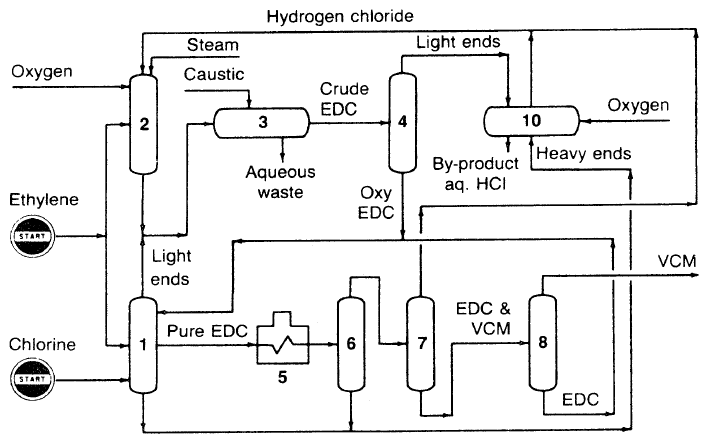


 علم الكيمياء
علم الكيمياء 
 الكيمياء التحليلية
الكيمياء التحليلية 
 الكيمياء الحياتية
الكيمياء الحياتية 
 الكيمياء العضوية
الكيمياء العضوية 
 الكيمياء الفيزيائية
الكيمياء الفيزيائية
 الكيمياء اللاعضوية
الكيمياء اللاعضوية 
 مواضيع اخرى في الكيمياء
مواضيع اخرى في الكيمياء
 الكيمياء الصناعية
الكيمياء الصناعية |
Read More
Date: 21-8-2017
Date: 20-12-2015
Date: 11-9-2017
|
Vinyl Chloride (CH2=CHCl)
Vinyl chloride is a reactive gas soluble in alcohol but slightly soluble in water. It is the most important vinyl monomer in the polymer industry. The U.S. production of vinyl chloride, the 16th highest-volume chemical, was approximately 14.8 billion pounds in 1994. Vinyl chloride monomer (VCM) was originally produced by the reaction of hydrochloric acid and acetylene in the presence of HgCl2 catalyst. The reaction is straightforward and proceeds with high conversion (96% on acetylene):

However, ethylene as a cheap raw material has replaced acetylene for obtaining vinyl chloride. The production of vinyl chloride via ethylene is a three-step process. The first step is the direct chlorination of ethylene to produce ethylene dichloride. Either a liquid- or a vapor-phase process is used:

The exothermic reaction occurs at approximately 4 atmospheres and 40–50°C in the presence of FeCl3, CuCl2 or SbCl3 catalysts. Ethylene bromide may also be used as a catalyst. The second step is the dehydrochlorination of ethylene dichloride (EDC) to vinyl chloride and HCl. The pyrolysis reaction occurs at approximately 500°C and 25 atmospheres in the presence of pumice on charcoal:

The third step, the oxychlorination of ethylene, uses by-product HCl from the previous step to produce more ethylene dichloride:

Ethylene dichloride from this step is combined with that produced from the chlorination of ethylene and introduced to the pyrolysis furnace. The reaction conditions are approximately 225°C and 2–4 atmospheres. In practice the three steps, chlorination, oxychlorination, and dehydrochlorination, are integrated in one process so that no chlorine is lost. Figure 1.1 illustrates the process.

Figure 1.1. The European Vinyls Corporation process for producing vinyl chloride: (1) chlorination section, (2) oxychlorination reactor, (3) steam stripping and caustic treatment of water effluent, (4) EDC distillation, (5) pyrolysis furnace, (6,7,8) VCM and EDC separation, (10)
by-product reactor.



|
|
|
|
دراسة يابانية لتقليل مخاطر أمراض المواليد منخفضي الوزن
|
|
|
|
|
|
|
اكتشاف أكبر مرجان في العالم قبالة سواحل جزر سليمان
|
|
|
|
|
|
|
اتحاد كليات الطب الملكية البريطانية يشيد بالمستوى العلمي لطلبة جامعة العميد وبيئتها التعليمية
|
|
|